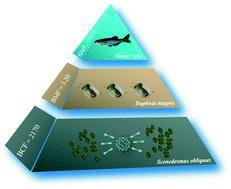当前位置:
X-MOL 学术
›
Environ. Sci.: Nano
›
论文详情
Our official English website, www.x-mol.net, welcomes your
feedback! (Note: you will need to create a separate account there.)
Trophic transfer and biomagnification of fullerenol nanoparticles in an aquatic food chain
Environmental Science: Nano ( IF 5.8 ) Pub Date : 2020-02-26 , DOI: 10.1039/c9en01277j Qiuyue Shi 1, 2, 3, 4, 5 , Cheng Long Wang 3, 5, 6, 7, 8 , Han Zhang 1, 2, 3, 4, 5 , Chunying Chen 5, 9, 10, 11 , Xian Zhang 1, 2, 3, 4, 5 , Xue-Ling Chang 3, 5, 6, 7, 8
Environmental Science: Nano ( IF 5.8 ) Pub Date : 2020-02-26 , DOI: 10.1039/c9en01277j Qiuyue Shi 1, 2, 3, 4, 5 , Cheng Long Wang 3, 5, 6, 7, 8 , Han Zhang 1, 2, 3, 4, 5 , Chunying Chen 5, 9, 10, 11 , Xian Zhang 1, 2, 3, 4, 5 , Xue-Ling Chang 3, 5, 6, 7, 8
Affiliation

|
Understanding the trophic transfer and biomagnification potential of nanomaterials in aquatic food chains is crucial for assessing the environmental risks of such materials. To analyse the fate of fullerenols in an aquatic food chain, we quantitatively investigated the bioaccumulation, tissue-specific distribution, depuration, trophic transfer and biomagnification potential of 13C-labelled fullerenols in a three-level aquatic food chain. The fullerenol nanoparticles accumulated in Scenedesmus obliquus through water exposure, and the latter were ingested by Daphnia magna before being transferred to Danio rerio. The tissues of D. rerio were ranked from highest to lowest fullerenol concentration as follows: intestine > liver > muscle > gills > brain. The biomagnification factor (BMF) value of fullerenols from S. obliquus to D. magna was 3.20, while the calculated fitted BMF from D. magna to D. rerio was less than 1 (BMFf = 0.54). Thus, fullerenols were significantly biomagnified from the first to the second trophic level but not from the second to the third trophic level. Although fullerenols eventually enter fish tissues via the food chain, a lack of biomagnification greatly reduce the potential risk to high-trophic-level aquatic organisms. These results will be useful for environmental and ecological risk assessments of carbon nanomaterials.
中文翻译:

富勒烯醇纳米粒子在水生食物链中的营养转移和生物放大作用
了解纳米材料在水生食物链中的营养转移和生物放大潜力对于评估此类材料的环境风险至关重要。为了分析水生食物链中富勒烯醇的命运,我们定量研究了三级水生食物链中13 C标记的富勒烯醇的生物累积,组织特异性分布,净化,营养转移和生物放大潜力。富勒烯醇纳米颗粒通过水暴露积累在斜生的场景中,后者被水蚤(Daphnia magna)摄入,然后转移到Danio rerio中。D. rerio的组织从最高到最低的富勒烯醇浓度排序如下:肠道>肝脏>肌肉>腮>脑。从斜纹链球菌到大假单胞菌的富勒烯醇的生物放大因子(BMF)值为3.20,而从大假单胞菌到里奥的D. rerio的拟合BMF小于1(BMF f = 0.54)。因此,从第一营养级到第二营养级将富勒烯醇显着生物放大,而从第二营养级到第三营养级则没有。尽管富勒烯醇最终会通过在食物链中,缺乏生物放大作用大大降低了对高营养水平水生生物的潜在风险。这些结果将有助于碳纳米材料的环境和生态风险评估。
更新日期:2020-02-26
中文翻译:

富勒烯醇纳米粒子在水生食物链中的营养转移和生物放大作用
了解纳米材料在水生食物链中的营养转移和生物放大潜力对于评估此类材料的环境风险至关重要。为了分析水生食物链中富勒烯醇的命运,我们定量研究了三级水生食物链中13 C标记的富勒烯醇的生物累积,组织特异性分布,净化,营养转移和生物放大潜力。富勒烯醇纳米颗粒通过水暴露积累在斜生的场景中,后者被水蚤(Daphnia magna)摄入,然后转移到Danio rerio中。D. rerio的组织从最高到最低的富勒烯醇浓度排序如下:肠道>肝脏>肌肉>腮>脑。从斜纹链球菌到大假单胞菌的富勒烯醇的生物放大因子(BMF)值为3.20,而从大假单胞菌到里奥的D. rerio的拟合BMF小于1(BMF f = 0.54)。因此,从第一营养级到第二营养级将富勒烯醇显着生物放大,而从第二营养级到第三营养级则没有。尽管富勒烯醇最终会通过在食物链中,缺乏生物放大作用大大降低了对高营养水平水生生物的潜在风险。这些结果将有助于碳纳米材料的环境和生态风险评估。











































 京公网安备 11010802027423号
京公网安备 11010802027423号